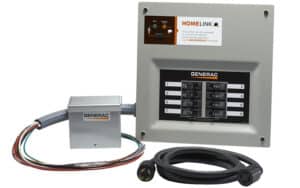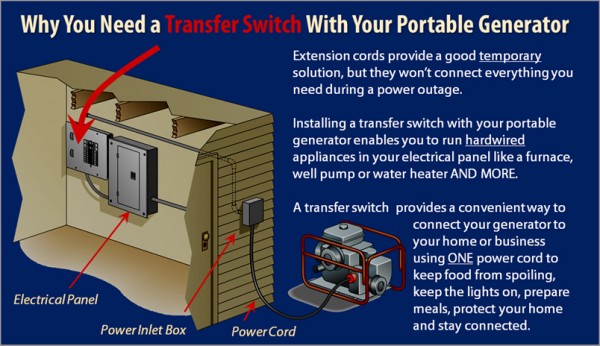The modification of your home’s electrical system requires a building permit and an inspection. Before planning your transfer switch installation, consult with your local building and code enforcement department to determine local installation requirements and building codes. Most will require a detailed plan that with a materials list and drawings that show equipment placement and the location of utilities before issuing a permit. Many will also require the survey showing property lines and buildings.
 A manual transfer switch connects your home’s electrical system to a portable generator for use during a power outage. A portable generator is not designed to power your entire home, but it can provide electric current to specific circuits you choose to power with your generator. The transfer switch isolates those circuits from the utility company which prevents your generator from endangering utility worker lives. It also provides a degree of overload protection for your generator by limiting the circuits connected to it. At the same time, your neighbors won’t be inadvertently drawing power from your generator, another possible source of overload.
A manual transfer switch connects your home’s electrical system to a portable generator for use during a power outage. A portable generator is not designed to power your entire home, but it can provide electric current to specific circuits you choose to power with your generator. The transfer switch isolates those circuits from the utility company which prevents your generator from endangering utility worker lives. It also provides a degree of overload protection for your generator by limiting the circuits connected to it. At the same time, your neighbors won’t be inadvertently drawing power from your generator, another possible source of overload.
 After connecting the wires from the generator inlet box and from the main breaker panel, the circuits which will receive power from the generator during an outage are disconnected from the circuit breakers inside the main service panel or load center, and reconnected to circuit breakers inside the transfer switch.
The generator is not wired to the transfer switch. Instead, it connects to the transfer switch through a four-wire power cord that plugs into the inlet box. The inlet box is hardwired to the transfer switch. This allows you to disconnect and store the generator when it is not in use.
After connecting the wires from the generator inlet box and from the main breaker panel, the circuits which will receive power from the generator during an outage are disconnected from the circuit breakers inside the main service panel or load center, and reconnected to circuit breakers inside the transfer switch.
The generator is not wired to the transfer switch. Instead, it connects to the transfer switch through a four-wire power cord that plugs into the inlet box. The inlet box is hardwired to the transfer switch. This allows you to disconnect and store the generator when it is not in use.
 A manual transfer switch connects your home’s electrical system to a portable generator for use during a power outage. A portable generator is not designed to power your entire home, but it can provide electric current to specific circuits you choose to power with your generator. The transfer switch isolates those circuits from the utility company which prevents your generator from endangering utility worker lives. It also provides a degree of overload protection for your generator by limiting the circuits connected to it. At the same time, your neighbors won’t be inadvertently drawing power from your generator, another possible source of overload.
A manual transfer switch connects your home’s electrical system to a portable generator for use during a power outage. A portable generator is not designed to power your entire home, but it can provide electric current to specific circuits you choose to power with your generator. The transfer switch isolates those circuits from the utility company which prevents your generator from endangering utility worker lives. It also provides a degree of overload protection for your generator by limiting the circuits connected to it. At the same time, your neighbors won’t be inadvertently drawing power from your generator, another possible source of overload.
Installation Overview
The manual transfer switch install begins with a new, double-pole, 240-volt circuit breaker inside the main service panel which supplies power from the electric utility to the transfer-switch utility breaker. Another breaker in the transfer switch connects to the generator. The two breakers are mechanically connected―turn either one on, and the other one turns off. This prevents both breakers from being in the “ON” position at the same time. Buyer Guide: What Size Portable Generator Do I Need?
Generac Homelink is the leading brand of manual and fully automatic transfer switches for backup power applications. A transfer switch allows your generator run hardwired appliances including the furnace, well pump, water heater, and air conditioner.


